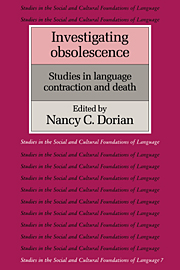Book contents
- Frontmatter
- Contents
- List of maps
- List of contributors
- Preface
- Map
- Dedication
- Introduction
- I Focus on context
- II Focus on structure
- 11 Problems in obsolescence research: The Gros Ventres of Montana
- 12 The structural consequences of language death
- 13 On signs of health and death
- 14 Case usage among the Pennsylvania German sectarians and nonsectarians
- 15 Estonian among immigrants in Sweden
- 16 The incipient obsolescence of polysynthesis: Cayuga in Ontario and Oklahoma
- 17 Urban and non-urban Egyptian Nubian: Is there a reduction in language skill?
- 18 Some lexical and morphological changes in Warlpiri
- 19 Language contraction and linguistic change: The case of Welland French
- 20 Lexical innovation and loss: The use and value of restricted Hungarian
- III Invited commentaries
- Bibliography
- Index of languages
- General index
16 - The incipient obsolescence of polysynthesis: Cayuga in Ontario and Oklahoma
Published online by Cambridge University Press: 08 January 2010
- Frontmatter
- Contents
- List of maps
- List of contributors
- Preface
- Map
- Dedication
- Introduction
- I Focus on context
- II Focus on structure
- 11 Problems in obsolescence research: The Gros Ventres of Montana
- 12 The structural consequences of language death
- 13 On signs of health and death
- 14 Case usage among the Pennsylvania German sectarians and nonsectarians
- 15 Estonian among immigrants in Sweden
- 16 The incipient obsolescence of polysynthesis: Cayuga in Ontario and Oklahoma
- 17 Urban and non-urban Egyptian Nubian: Is there a reduction in language skill?
- 18 Some lexical and morphological changes in Warlpiri
- 19 Language contraction and linguistic change: The case of Welland French
- 20 Lexical innovation and loss: The use and value of restricted Hungarian
- III Invited commentaries
- Bibliography
- Index of languages
- General index
Summary
Cayuga, an Iroquoian language, was originally spoken in what is now New York State. When first encountered by Europeans, the Cayuga lived in villages around Cayuga Lake, surrounded by the other related Five Nations Iroquois. To the west were the Seneca, to the east the Onondaga, beyond them the Oneida, and finally, the Mohawk. Due to a series of unfortunate events, Cayuga speakers now live in two distantly separated communities, one in Ontario and the other in Oklahoma. While the language is still very much alive in Ontario, it is receding in Oklahoma, as fewer and fewer speakers use it on rarer and rarer occasions. Not surprisingly, the Cayuga spoken in Oklahoma has begun to differ in subtle ways from that spoken in Ontario.
Historical background
The Cayuga had occupied the same land for centuries before the American Revolution. When war erupted, they were drawn into battle on the side of the British, and in 1779 an American expedition destroyed their villages. This led to their dispersal. Some Cayugas remained with their land, but others went to live with Senecas at Buffalo Creek, and still others went with other Iroquoians to Ontario to form the Six Nations Reserve. By the end of the Revolution, only about 130 Cayugas remained at Cayuga Lake, 350 were with the Seneca at Buffalo Creek, and 382 were at Six Nations. (For a detailed discussion of the history of the Cayuga, see Sturtevant 1978; White, Englebrecht and Tooker 1978.)
- Type
- Chapter
- Information
- Investigating ObsolescenceStudies in Language Contraction and Death, pp. 243 - 258Publisher: Cambridge University PressPrint publication year: 1989
- 11
- Cited by



